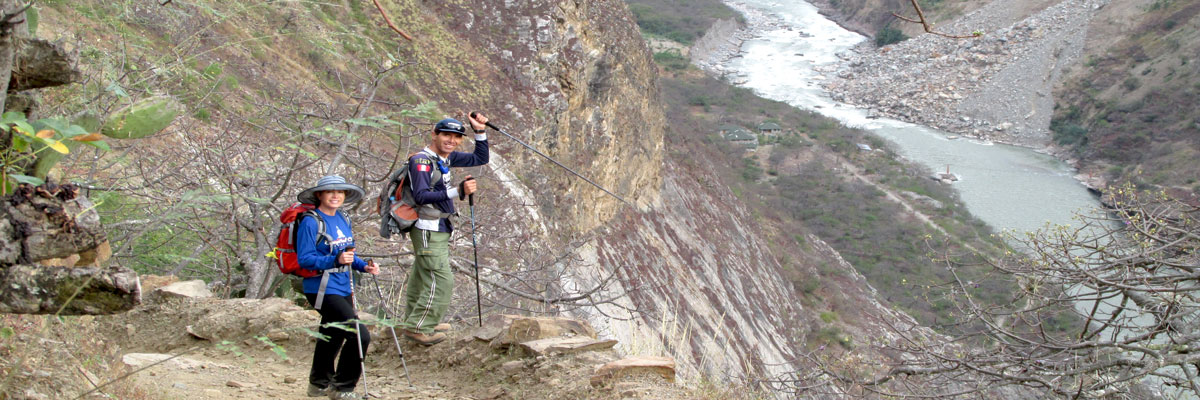
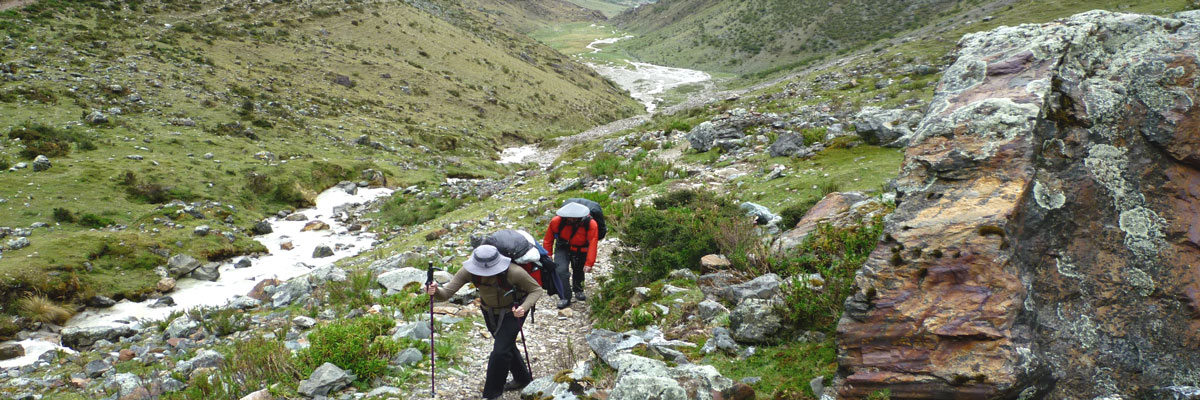
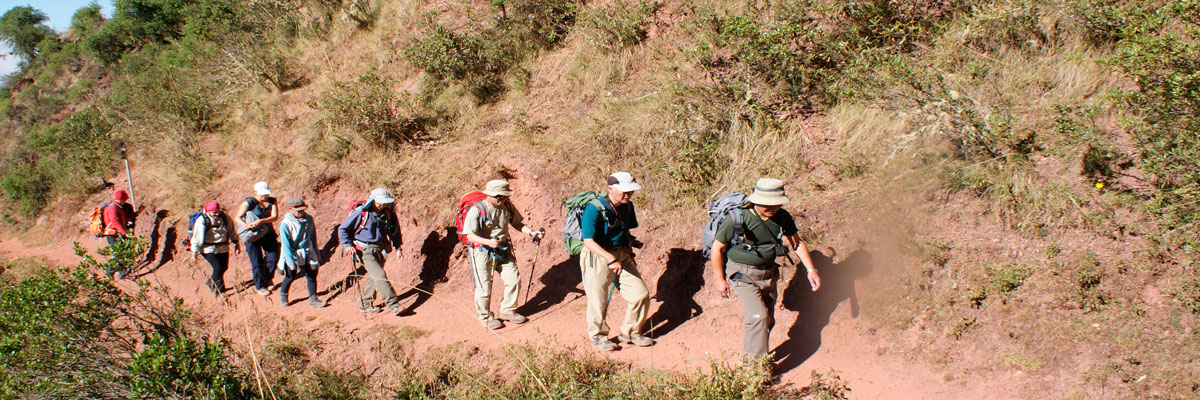
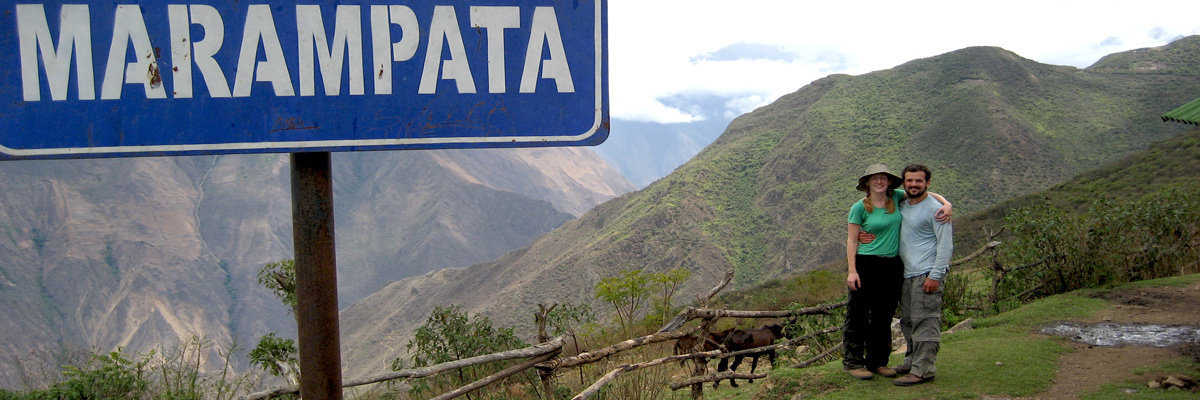
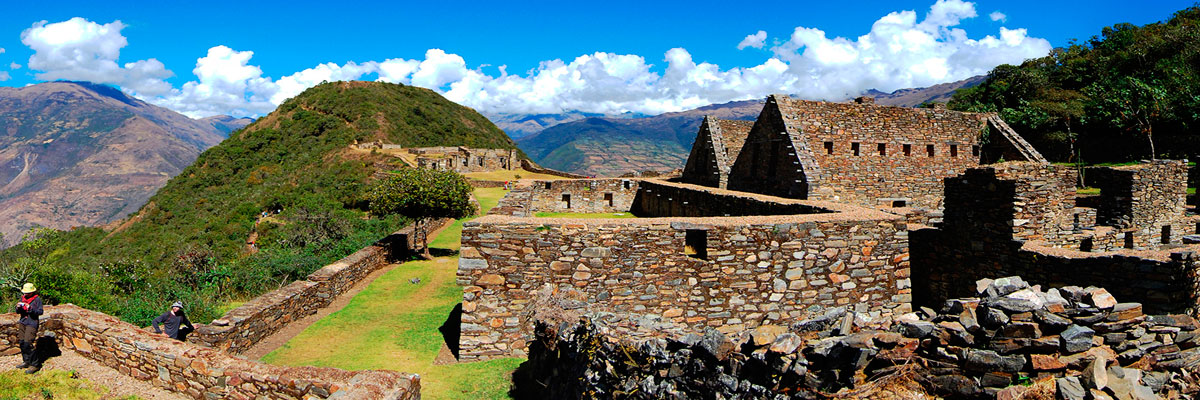





Camp under the stars and trek from snow-covered peaks down through the tropical river valley of Apurímac Canyon and hike up to the high jungle which for centuries hid the two most impressive of Peru's Inca sites: the lost city of Choquequirao (Aymara for 'Cradle of Gold') and Machu Picchu (Quechua for 'Old Peak'). This challenging, unconventional adventure will take us through small Andean villages, along Inca paths and everchanging landscapes.
Early in the morning, at the agreed time we'll pick you up at your hotel and head by car to San Pedro de Chachora (28masl) a town in Abancay Province. At Cahora we will arrange our supplies, camping and cooking equipment on the mules. We'll begin our hike around 11:00am, hiking for about 2½ hours to Capuliyoc (2750masl), 11.5km away. At this site we will rest and enjoy our lunch before beginning the 8km zigzag descent to our first campsite. Along the way we'll enjoy amazing views of one of the world's deepest canyons, Apurímac, especially from Cocamazana viewpoint, from where we'll also be able to see Choquequirao and our campsite. When we reach Chikisca we'll shower, set up camp, have dinner and spend the night.
After an early and replenishing breakfast we'll descend to the low-point of our hike, the mighty Apurimac River (1850masl), whose cold waters are fed by runoff from the glacial peaks. Crossing the river by bridge, we'll begin to hike to our lunch site Marampata. It will take about 5 hours to make it from the river to our campsite for the night, Choquequirao Camp, near Choquequirao Archeological site. The area surrounding this famous ruined city, with the Apurímac river roaring below it, is majestic, flanked by thick forest pushing up the eastern slopes of the mighty Andean range, circled by its snow-capped peaks. The cold stretches are characterized by ichu prairie grass, and the warmer stretches boast varieties of orchids. The wildlife of this highly diverse area has adapted to the strong daytime sun and cold nightly frosts. It includes the rooster of the rocks (the bright national bird of Peru), foxes, vizcachas, condors, skunks, pumas, hummingbirds, and bears.
We'll share a delicious breakfast and then explore the agricultural terraces of the lower section of the Choquequirao site before hiking up behind the mountain and descending to the famous ruins of Choquequirao, one of the last bulwark of Inca resistance, where Manco Inca retreated after Cusco fell to the Spanish. The last Inca, Tupac Amaru, is believed to have been raised here among priestesses.
Its temples, fortress, Inca homes, storehouses, fountains and canals, main plaza and ceremonial platform, and Andean terraces provide priceless insight into the Inca world despite the fact that only 30%, or 1810 hectares, of the site has been uncovered and restored. We'll enjoy our lunch at Blanco River before hiking to Maizal, and go to our campsite for the night.
In the morning of day four we'll climb to the San Juan Pass with its impressive panoramic views. After lunch, we'll descend along a route taking us past the Victoria Mineshafts, where we'll be able to catch sight of the silver particles. We'll constinue our descent route into the Yanama River Valley, with its lush greenery and waterfalls, where we'll set up camp for the night..
After a delicious breakfast our day's hike begins as we ascend along a route to Yanama Pass (4300masl) that will show us views of Corihuaynachina glacier. After this point the path is downhill and we'll enter Totora Valley. While in the valley we'll stop for lunch and pass various small villages along the trail. The descent will continue until Collpapampa Valley, where we will camp. This is where the ridge often called the 'eyebrow' of the jungle begins.
Today we'll enjoy a change of landscape and vegetation, passing various fruit (lemons, bananas, oranges, etc) and coffee plantations as we descend. Those who wish may relax in one of the natural thermal baths along the trail. (Entry cost is not included.) Our campsite on this day will be the famous Zahauyaco, colloquially know as 'The Beach' or La Playa, a riverside paradise boasting a tropical climate. At this point we will say goodbye to our muleteer, who will not be continue with us.
In the morning after our breakfast we will take a local microbus to Santa Teresa. At that point its a little less than an hour walk to the Vilcanota River, from where we'll continue to the Hydroelectric station by truck. At the Hydroelectric we'll have lunch and then take the train Aguas Calientes (the colloquial name for Machu Picchu Pueblo). This is the small but vibrant base-town from which visitors access the ruins. Dinner on this day will be in a local restaurant, and we'll spend the night in town. (This is not a camping night.)
On the final day we'll wake up very early for breakfast, around 4:00am, and leave for Machu Picchu Archeological Complex. Our aim is to watch the sun rise over the mysterious ruins and beat the crowds arriving on the first trains. Our guide will spend about two hours taking us through the site so that we can learn about Machu Picchu's enigmatic history and the significance of the site's most striking structures. Ending at the most important site of any Inca city, the Sun Temple's Intihuatana, a solar clock famously designed to align with the sun on the equinoxes, appearing to hold the sun in place for some moments. After the tour you'll have free time to take photos and explore the citadel on your own before we need to return to Aguas Calientes. You'll have time to have lunch in town before we catch the evening train returning to the Imperial city of Incas and our starting-point, Cusco.
Private